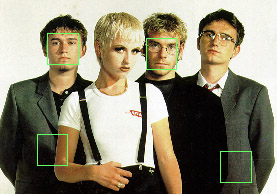Recognition Test Results:
1. Average face and 10 eigenfaces
![]() :
: ![]()
![]()
![]()
![]()
![]()
![]()
![]()
![]()
![]()
![]()
2. Recognition results plot:

Q&A:
Q: Describe the trends you see in your plots. Discuss the tradeoffs; how many eigenfaces should one use? Is there a clear answer?
From this specific experiment, it seems that the more eigenfaces used, the better recognition results are. The tradeoff here is between computation and accuracy. The optimal number of eigenfaces in this specific experiment should be 21, since using more eigenfaces won't help any more. But how to decide such an optimal value isn't very obvious.
Q: You likely saw some recognition errors in step 3; show images of a couple. How reasonable were the mistakes? Did the correct answer at least appear highly in the sorted results?
Here is a wrongly recognized example: smiling face of  was recognized to
was recognized to  , where the correct answer should be
, where the correct answer should be  . The result is reasonable because the result is ranked from MSE calculated, which won't be the same as perceptual recognition. In this case the correct nonsmiling face ranked No.2, but there is no general comments on whether the correct answer will appear highly in the sorted results becase one can smile in many ways.
. The result is reasonable because the result is ranked from MSE calculated, which won't be the same as perceptual recognition. In this case the correct nonsmiling face ranked No.2, but there is no general comments on whether the correct answer will appear highly in the sorted results becase one can smile in many ways.
Cropping and finding faces Results:
1. The face of the famous Aseem is found correctly ![]() (0.45, 0.55, 0.01).
(0.45, 0.55, 0.01).
2. Result for the photo of Jonny Depp:  (0.35, 0.45, 0.01).
(0.35, 0.45, 0.01).
3. Results for group1:  with scale (0.9, 1.0, 0.05).
with scale (0.9, 1.0, 0.05).
4. Results for group photo:  (0.75, 0.85, 0.03).
(0.75, 0.85, 0.03).
Q&A:
Q: What min_scale, max_scale, and scale step did you use for each image?
All scales are noted along with images.
Q: Did your attempt to find faces result in any false positives and/or false negatives? Discuss each mistake, and why you think they might have occurred.
There are many situations the algorithm fails, such as illumination change across the face (not modeled in the learning data), face orientation (only frontal faces in training data), and some faces are just too different from the training sets (too far away from the training data cluster).
Extra Credits:
1. Speedup algorithm for Eigenface generation
2. Verify algorithm, I use threshold 18000, which is chosen to minimize the sum of false-alarm rate & detection-error rate. Optimally it should be some function of two, or weighted sum of two, and the weight will depends on different applications. In the result both rate are 6/33.
3. I used the subspace density estimation method described in section 3.1 of the survey paper. Essentially it gives an probability estimate of the input image by calculating equation (11), and then find the best matching by selecting highest probabilities. Equivalently I evaluated ![]() , and use that to rank different search positions in face-searching. Notice the eigen.face file format is changed to store those eigenvalues and the parameter rou.
, and use that to rank different search positions in face-searching. Notice the eigen.face file format is changed to store those eigenvalues and the parameter rou.